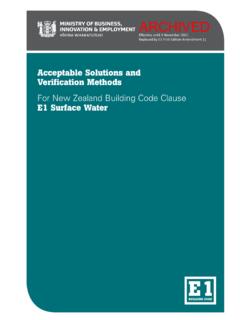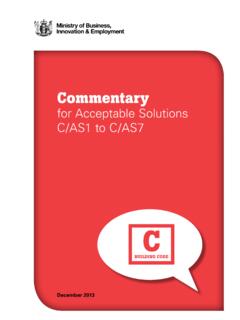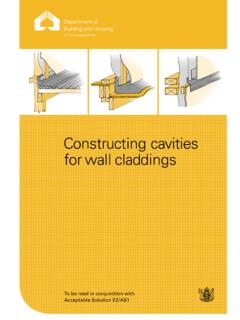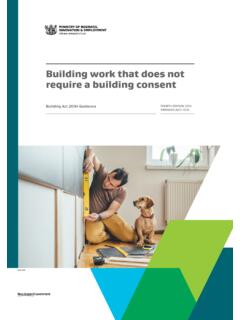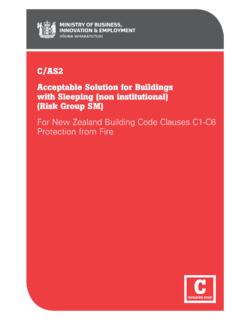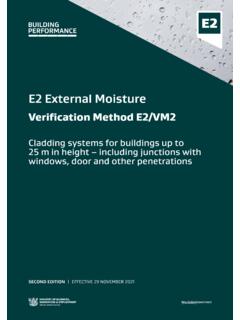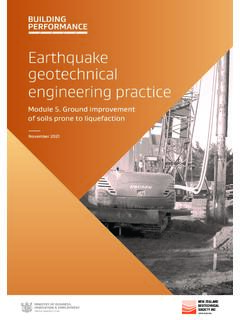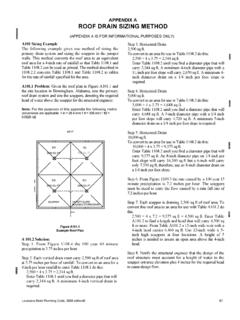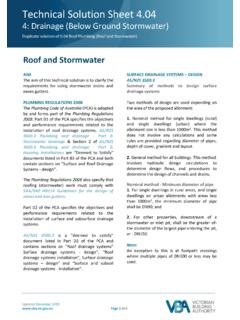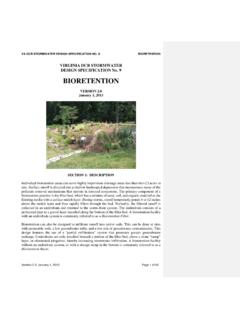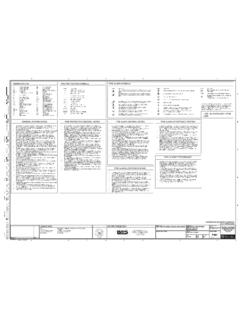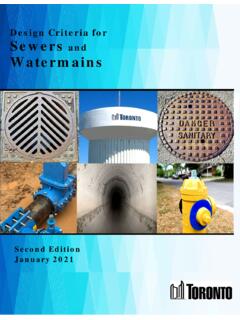Transcription of Acceptable Solutions and Verification Methods
1 Acceptable Solutions and Verification Methods For New Zealand Building Code ClauseE1 Surface WaterE12 Status of Verification Methods and Acceptable SolutionsVerification Methods and Acceptable Solutions are prepared by the Ministry of Business, Innovation and Employment in accordance with section 22 of the Building Act 2004. Verification Methods and Acceptable Solutions are for use in establishing compliance with the New Zealand Building person who complies with a Verification Method or Acceptable Solution will be treated as having complied with the provisions of the Building Code to which the Verification Method or Acceptable Solution relates. However, using a Verification Method or Acceptable Solution is only one method of complying with the Building Code. There may be alternative ways to should make themselves familiar with the preface to the New Zealand Building Code Handbook, which describes the status of Verification Methods and Acceptable Solutions and explains alternative Methods of achieving words (italicised in the text) and classified uses are explained in Clauses A1 and A2 of the Building Code and in the Definitions at the start of this about the content of this document should be directed to: Ministry of Business, Innovation and EmploymentPO Box 1473, Wellington 6140 Telephone 0800 242 243 Email: Methods and Acceptable Solutions are available from Ministry of Business, Innovation and Employment 2020 This document is protected by Crown copyright, unless indicated otherwise.
2 The Ministry of Business, Innovation and Employment administers the copyright in this document. You may use and reproduce this document for your personal use or for the purposes of your business provided you reproduce the document accurately and not in an inappropriate or misleading context. You may not distribute this document to others or reproduce it for sale or Ministry of Business, Innovation and Employment owns or has licences to use all images and trademarks in this document. You must not use or reproduce images and trademarks featured in this document for any purpose (except as part of an accurate reproduction of this document) unless you first obtain the written permission of the Ministry of Business, Innovation and : Document HistoryDateAlterationsFirst publishedJuly 1992 Amendment 1 September 1993pp. vi and vii, References p. 14, , Figure 3 p. 16, Table 2 p. 18, p.
3 20, Figure 13p. 21, Figure 14 p. 22, Table 4, Table 5, , , p. 23, Figure 15, Figure 16 p. 24, , 219 August 1994pp. i and ii, Document History p. vi, NZS 3441 replaced NZS 3403p. 21, p. 22, Table 4, Table 5 p. 24, , Table 6 Reprinted incorporating Amendments 1 and 2 October 1994 Amendment 31 December 1995p. ii, Document Historyp. iii, incorporating Amendments 1, 2 and 3 July 1996 Amendment 41 December 2000 p. ii, Document History p. v, Contents pp. vi and vii, Referencesp. viii, Definitions pp. 1 12K, Revised VM1pp. 27 and 28, IndexAmendment 5p. 2, Document History, Status p. 7, References p. 31, 39, p. 42, 66 January 2002p. 3 Code Clause E1 Reprinted incorporating Amendments 4, 5 and 6 September 2003 Amendment 7 Published 30 June 2010 Effective from 30 September 2010p. 2, Document History, Status pp. 7 and 8, References pp. 9 and 10, Definitions p. 34, E1/AS1 Table 1 p.
4 37, E1/AS1 Table 3p. 41, E1/AS1 p. 42, E1/AS1 Table 4 p. 44, E1/AS1 Table 6 p. 47, IndexReprinted incorporating Amendment 7 30 September 2010 Erratum 1 30 September 2010p. 43, Figure 16 Amendment 8 Effective from 10 October 2011 until 14 August 2014p. 2, Document History, Status pp. 7 and 8, References p. 9, Definitionsp. 34, E1/AS1 Table 1 p. 37, E1/AS1 Table 3p. 42, E1/AS1 Table 4 Amendment 914 February 2014 until 30 May 2017 p. 2A Document History, Status p. 7 References p. 9 Definitionsp. 41, E1/AS1 p. 44, E1/AS1 StatusThe most recent version of this document (Amendment 11), as detailed in the Document History, is approved by the Chief Executive of the Ministry of Business, Innovation and Employment. It is effective from 5 November 2020 and supersedes all previous versions of this previous version of this document (Amendment 10) will cease to have effect on 3 November using this document should check for amendments on a regular basis.
5 The Ministry of Business, Innovation and Employment may amend any part of any Verification Method or Acceptable Solution at any time. Up-to-date versions of Verification Methods and Acceptable Solutions are available from : Document History (continued)DateAlterationsAmendment 10 Effective 1 January 2017 until 3 November 2021pp. 7, 8 Re1erences p. 12 E1/ VM1 Table 1p. 31 E1/ VM1 11 Effective 5 November 2020p. 5 Contents pp. 7 8 References p. 9 Definitions p. 13 E1/ VM1 p. 34 E1/AS1 , Table 1 p. 37 E1/AS1 p. 40 E1/AS1 Figure 13 p. 44 E1/AS1 , Table 6 pp. 45 51 E1/AS1 appendix A pp. 52 55 New Acceptable Solution E1/AS2 includedp. 57 IndexNote: Page numbers relate to the document at the time of Amendment and may not match page numbers in current Zealand Building Code Clause E1 Surface WaterSURFACE WATERDEPARTMENT OF BUILDING AND HOUSINGC lause E16 January 2002 The mandatory provisions for building work are contained in the New Zealand Building Code (NZBC), which comprises the First Schedule to the Building Regulations 1992.
6 The relevant NZBC Clause for Surface Water is shall apply only to Housing, Communal Residential and Communal Non-residential The objective of this provision is to:(a) Safeguard people from injury or illness, and other property from damage, caused by surface water, and(b) Protect the outfalls of drainage Buildings and sitework shall be constructed in a way that protects people and other property from the adverse effects of surface Except as otherwise required under the Resource Management Act 1991 for the protection of other property, surface water, resulting from an event having a 10% probability of occurring annually and which is collected or concentrated by buildings or sitework, shall be disposed of in a way that avoids the likelihood of damage or nuisance to other Surface water, resulting from an event having a 2% probability of occurring annually, shall not enter Drainage systems for the disposal of surface water shall be constructed to.
7 (a) Convey surface water to an appropriate outfall using gravity flow where possible,(b) Avoid the likelihood of blockages,(c) Avoid the likelihood of leakage, penetration by roots, or the entry of ground water where pipes or lined channels are used,Limits on application FIRST SCHEDULE continued Clause E1 SURFACE WATERA mend 6 Jan 2002 Amend 6 Jan 2002 Amend 6 Jan 20024 July 1992 DEPARTMENT OF BUILDING AND HOUSINGC lause E1 SURFACE WATERP rovisions (d) Provide reasonable access for maintenance and clearing blockages,(e) Avoid the likelihood of damage to any outfall, in a manner Acceptable to the network utility operator, and(f) Avoid the likelihood of damage from superimposed loads or normal ground on application 1992/150 Building Regulations 1992 37 FIRST SCHEDULE continued5 SURFACE WATERMINISTRY OF BUSINESS.
8 INNOVATION AND EMPLOYMENT5 November 2020 Contents E1/VM1 & AS1/AS25 PageReferences 7 Definitions 9 Verification Method E1/VM1 Scope Estimation of Surface Water Run-off Run-off coefficient Rainfall intensity Time of concentration sizing of Surface Water System Minimum size of drains Hydraulic design Pipe materials Secondary Flow Secondary flow from a piped surface water drainage system upstream of the site Secondary flow from an open water course upstream of the site Secondary flow from site to downstream drainage system Energy Losses Through Structures Minimum Velocity Outfall Protection Drain Leakage Tests Water test Low pressure air test High pressure air test Disposal to soak pit 30 PageAcceptable Solution E1/AS1 Limitations of the Solution Minimum Acceptable Floor Level Drainage System Materials and Construction Materials sizing of drains Alignment and gradient of drains Minimum gradients Jointing of drains Surface water inlets to drains Access for maintenance Testing of drains Bedding and backfilling Downpipes Materials sizing of downpipes Installation of downpipes roof Gutters Size of roof gutter Materials Gradients Thermal movement Overflow outlets 44E1/AS1 appendix A Rainfall intensities 45 Acceptable Solution E1/AS2 AS/NZS Stormwater drainage 52 Index 56 ContentsAmend 4 Dec 2000 Amend 4 Dec 2000 Amend 11 Nov 20206 Amends 9, 10.
9 117 For the purposes of New Zealand Building Code (NZBC) compliance, the Standards and documents referenced in this Verification Method and Acceptable Solutions (primary reference documents) must be the editions, along with their specific amendments, listed below. Where these primary reference documents refer to other Standards or documents (secondary reference documents), which in turn may also refer to other Standards or documents, and so on (lower-order reference documents), then the version in effect at the date of publication of this Verification Method and Acceptable Solutions must be used. Where quotedStandards New ZealandNZS/BS 970:- Specification for wrought steels for mechanical and allied engineering purposes Part 1: 1991 General inspection and testing procedures and AS1 Table 4, specific requirements for carbon, carbon Table 6 manganese, alloy and stainless steels Amend: 1 AS/NZS 1254: 2010 PVC pipes and fittings for stormwater and surface AS1 Table 1, water applications Table 3 Amend: 1, 2AS/NZS 1260: 2017 PVC-U Pipes and fittings for drain, waste and AS1 Table 1, vent application Table 4 AS/NZS 1734: 1997 Aluminium and aluminium alloys Flat sheets, AS1 Table 4, coiled sheet and plate Table 6AS/NZS 2032: 2006 Installation of PVC Pipe Systems AS1 Table 3, Amend: 1AS/NZS 2033: 2008 Installation of polyethylene pipe systems AS1 Table 3 Amend: 1, 2AS/NZS 2280.
10 2014 Ductile iron pipes and fittings AS1 Table 1, Amend: 1, 2 Table 3 AS/NZS 2566:- Buried Flexible pipelines Part 1: 1998 Structural Design AS1 Part 2: 2002 Installation AS1 , Table 3 Amend: 1, 2, 3AS/NZS 3500:- Plumbing and drainage Part 3: 2018 Stormwater drainage AS2 , , 3604: 2011 Timber framed buildings AS1 AS/NZS 4058: 2007 Precast concrete pipes (pressure and non-pressure) AS1 Table 1AS/NZS 4130: 2018 Polyethylene (PE) pipes for pressure applications AS1 Table 1 SURFACE WATERMINISTRY OF BUSINESS, INNOVATION AND EMPLOYMENT5 November 2020 References E1/VM1 & AS1/AS27 ReferencesAmend 1 Sep 1993 Amend 1 Sep 1993 Amend 7 Sep 2010 Amend 7 Sep 2010 Amends 1, 4, 7, 8, 9 Amend 7 Sep 2010 Amend 8 Oct 2011 Amend 8 Oct 2011 Amend 5 July 2001 Amend 8 Oct 2011 Amend 8 Oct 2011 Amend 9 Feb 2014 Amends9 and 11 Amend 9 Feb 2014 Amends 9, 10, 11 Amends8 , 9, 10, 11 Amend 10 Jan 2017 Amends 10 and 11 Amend 11 Nov 2020 Amend 11 Nov 2020 Amend 11 Nov 2020 NZS 4229: 2013 Concrete masonry buildings not requiring AS1 specific design NZS 4442: 1988 Welded steel pipes and fittings for water, sewage AS1 Table 1, and medium pressure gas Table 3 AS/NZS 5065: 2005 Polyethylene and polypropylene pipe and fittings for AS1 Table 1 drainage and sewerage applications Amend.
